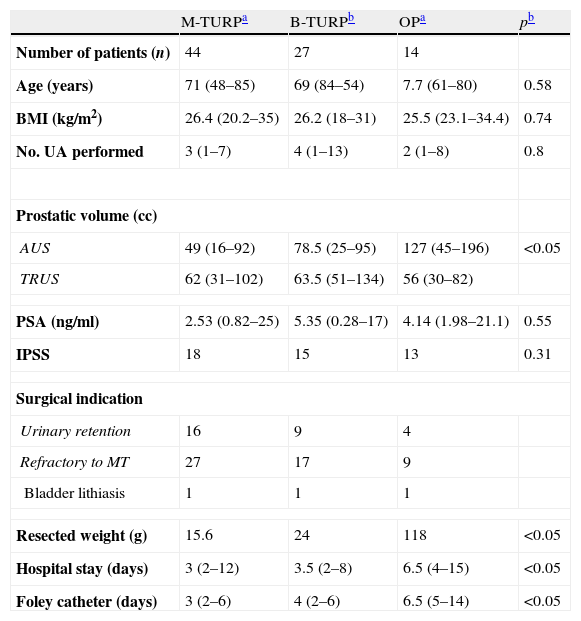Urinalysis alterations are common after prostatic surgery. However, time to normalization has not been established. Presence of pyuria and microhematuria can lead to unnecessary diagnostic procedures. The objective of this study is to determine the time to normalization for both parameters.
Materials and methodsWe reviewed medical records of patients who underwent prostatic surgery without infectious complications during follow-up. We included patients who underwent transurethral resection of the prostate (TURP) with either monopolar or bipolar energy, or open prostatectomy (OP). Kaplan–Meier curves were used to determine the time of persistence of both parameters. ANOVA was used to compare the 3 groups according to the type of surgery. We analyzed the impact of preoperative use of 5-α-reductase inhibitors, and searched for a correlation between the weight of resected tissue and persistence of both parameters.
Results85 patients were analyzed: 44 underwent monopolar TURP, 27 bipolar TURP, and 14 OP. Persistence of pyuria was significantly longer than microhematuria with a median of 274 days vs. 176 days. Neither the use of monopolar or bipolar energy, nor the use of preoperative 5α-reductase inhibitors affected the persistence time. We found a positive correlation between the resected tissue weight and the persistence of leukocyturia after endoscopic surgery: 23g was the best cut-off point.
ConclusionsPyuria persists longer than microhematuria regardless of the type of surgery. There is a correlation between the resected tissue weight and the persistence of this feature. The presence of pyuria and microhematuria after prostatic surgery is not always a pathological finding.
Las alteraciones del examen general de orina (EGO) son comunes después de la cirugía prostática. Sin embargo, el tiempo de normalización no ha sido establecido. La presencia de estas alteraciones puede propiciar abordajes diagnósticos innecesarios. El objetivo de este estudio es determinar el tiempo de normalización para ambos parámetros.
Material y métodosEstudiamos pacientes sometidos a cirugía prostática sin complicaciones infecciosas durante su seguimiento. Incluimos pacientes sometidos a resección transuretral de próstata (RTUP) con energía monopolar y bipolar y a prostatectomía abierta (PA). Se utilizaron curvas de Kaplan-Meier para determinar el tiempo de persistencia. Se utilizó ANOVA para comparar los 3 grupos de acuerdo a la cirugía. Analizamos el impacto del uso preoperatorio de inhibidores de la 5-alfa reductasa y correlacionamos el peso del tejido resecado con la persistencia de ambos parámetros.
ResultadosAnalizamos 85 pacientes: 44 sometidos a RTUP monopolar, 27 a RTUP bipolar y 14 a PA. El tiempo de persistencia de piuria fue significativamente mayor que el de microhematuria, con una mediana de 274 vs 176 días. Estos resultados no se vieron afectados por el tipo de energía utilizada, ni por el uso de inhibidores de la 5-alfa reductasa. Encontramos una correlación entre el peso del tejido resecado y la persistencia de piuria posterior a cirugía endoscópica: 23g (fue el mejor punto de corte).
ConclusionesLa piuria persiste más que la microhematuria. Existe una correlación entre el tejido resecado y la persistencia de piuria. La presencia de estas alteraciones después de la cirugía prostática no siempre es un hallazgo patológico.
Artículo
Comprando el artículo el PDF del mismo podrá ser descargado
Precio 19,34 €
Comprar ahora











